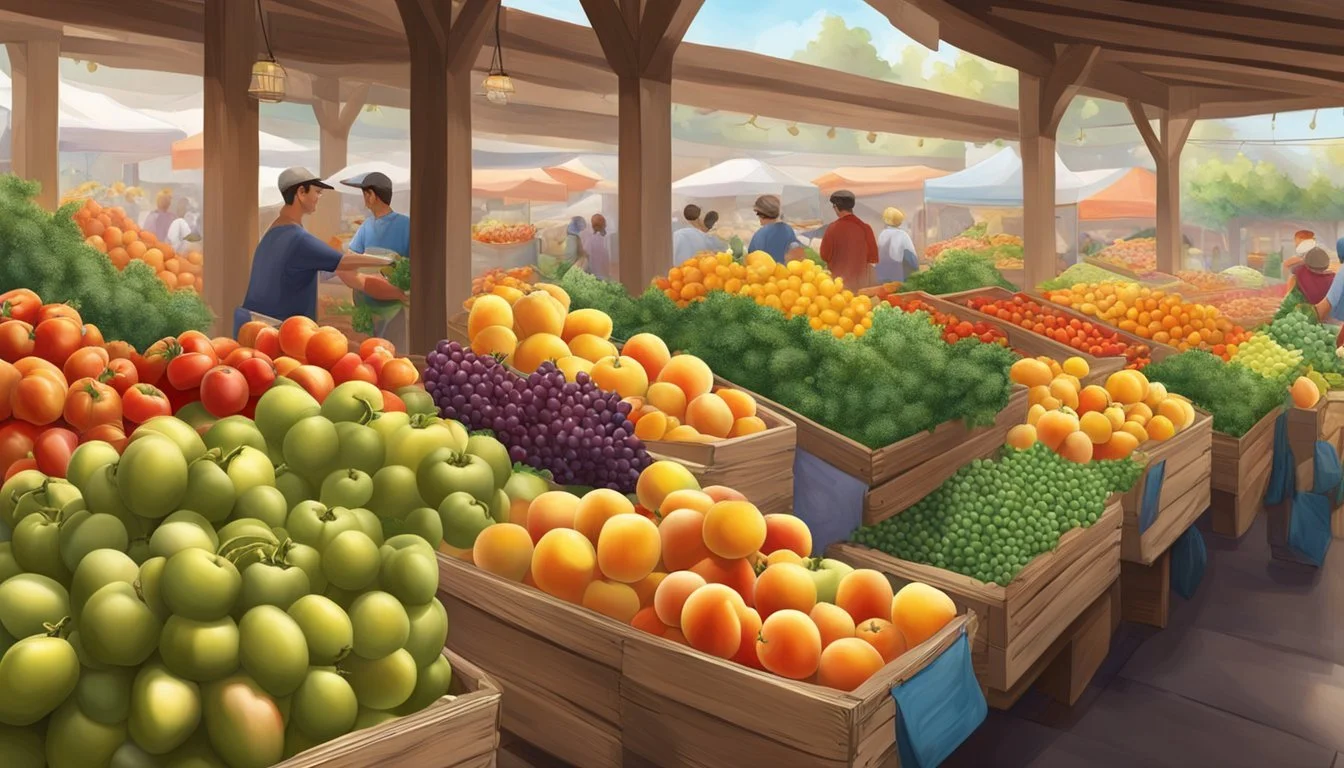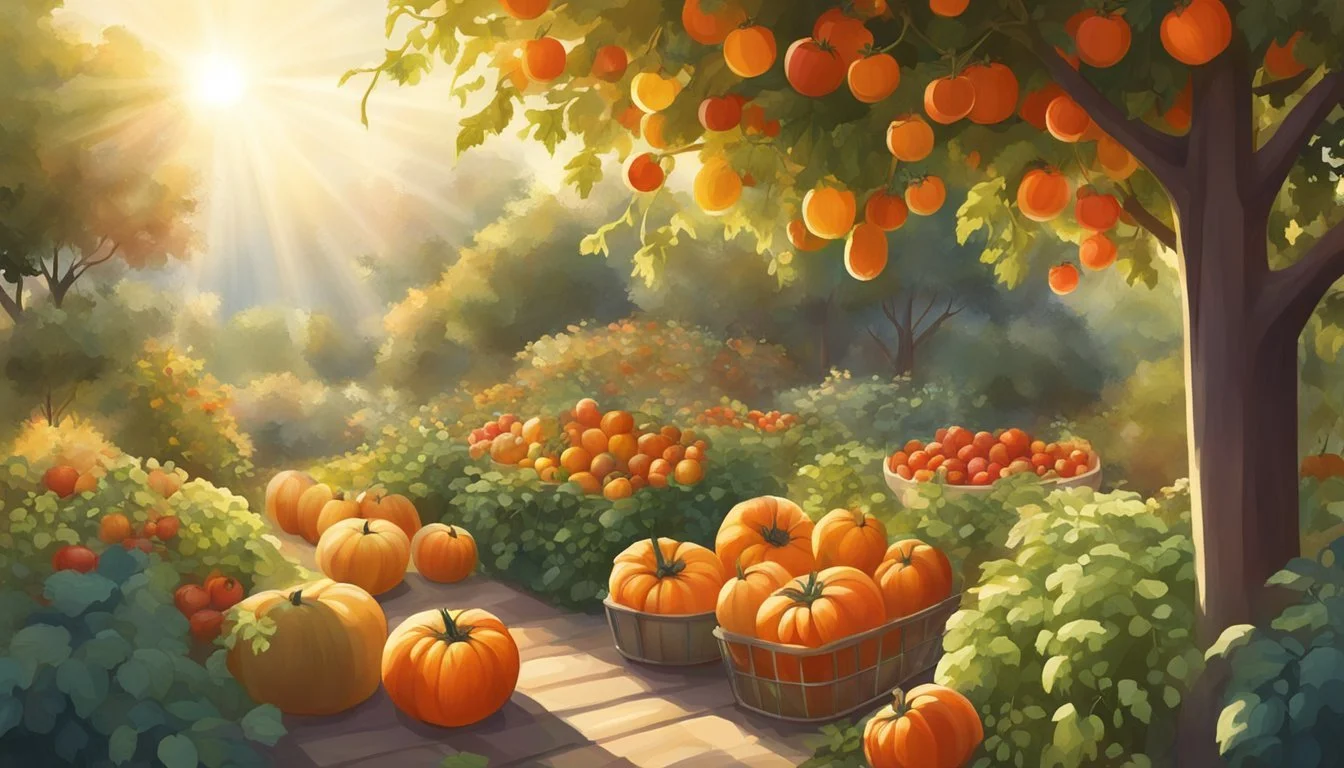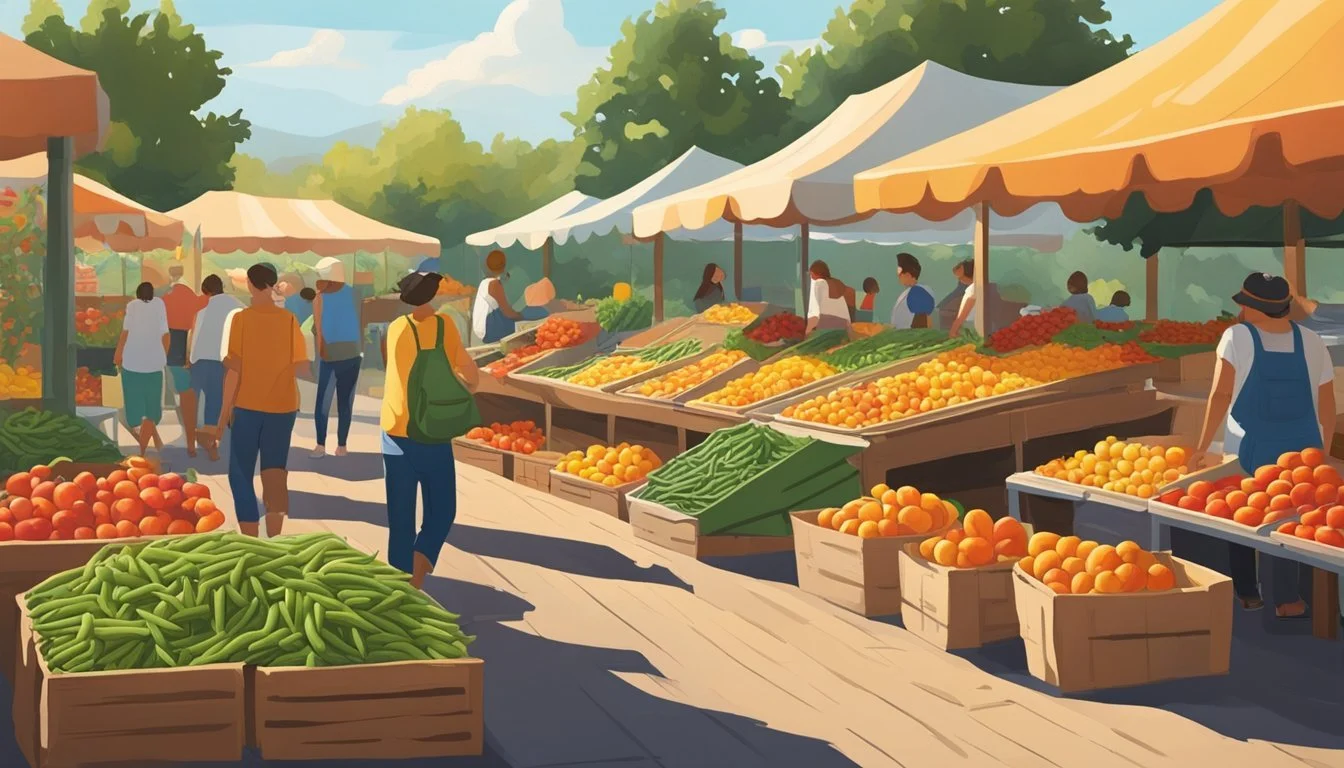Arkansas Seasonal Fruit & Vegetables in September
Your Fresh Produce Guide
This Article is Part of our Arkansas Seasonal Fruit & Veg Calendar
As September arrives in Arkansas, it marks an opportune time for those who appreciate the bounty of local produce. The state experiences a diverse range of fruits (What wine goes well with fruit?) and vegetables reaching their peak, providing consumers with a fresh and flavorful harvest. During this month, nature's transition is evident as the last of the warm-weather crops are collected and the first of the cool-weather varieties make their appearance.
Arkansas's climate and fertile soil contribute to the successful growth of a variety of produce that can be sourced directly from local farms, farmers' markets, and even backyard gardens. September's seasonal selection includes an array of fruits and vegetables that are not just rich in taste but are also packed with nutrients. This is the perfect time for Arkansans and visitors alike to explore and enjoy the freshest produce the state has to offer.
Understanding Arkansas's Growing Season
In Arkansas, September is a transitional month, bridging the gap between the heat of summer and the cooler temperatures of fall. It is a pivotal time for harvesting a variety of fruits and vegetables that thrive in these conditions.
The state falls into the USDA Hardiness Zones 6 through 8. This classification influences the type of crops that can be grown and when they are in season. In late summer and early fall, Arkansas gardeners and farmers are busy with the harvest as many crops reach peak readiness.
During this period, the following produce is typically in season:
Vegetables:
Tomatoes
Cucumbers
Squash
Fruits:
Apples (how long do apples last?)
Pears
Muscadines
Late summer Peaches
The warm days and mild nights create an ideal environment for these fruits and vegetables to come to fruition. Arkansas's climate permits a prolonged growing season, allowing for both summer and early fall crops to coexist.
Gardeners should remain attentive to the shift in weather patterns. As the season progresses from late summer into early fall, certain precautions may be necessary to protect sensitive crops from an early frost.
By understanding the nuances of Arkansas's growing season, one can optimize their planting strategies to ensure a successful harvest. The month of September, with its blend of summer warmth and impending cool, is a testament to the state’s diverse agricultural potential.
Fruits to Enjoy in September
September in Arkansas brings a diverse bounty of fruits at their peak ripeness, offering a burst of flavors from the sweet to the tangy. This is the time for fruit lovers to enjoy the last of summer's sweetness and the beginnings of fall's harvest.
Berries of Arkansas
In early September, blackberries and blueberries have generally passed their peak season, but one may still find the tail end of these berries at local markets. They are perfect for making jams, desserts, or simply enjoying fresh.
Blackberries: A rich source of vitamins and antioxidants.
Blueberries: Known for their sweet-tart flavor and nutritional benefits.
Tree Fruits
As summer wanes, tree fruits come into prominence, making September an excellent month for Arkansas fruit enthusiasts.
Apples: A hallmark of the fall, with many varieties available.
Pears: Ripe and ready, offering a soft, buttery texture.
Plums: Juicy and rich in vitamin C, a lesser-known but delicious choice.
Peaches: By early September, peaches are often at the end of their season but still findable.
Persimmons: Late September may see the start of the persimmon season, with its unique, sweet taste.
Melons
While melons are most often associated with summer, some varieties are still in season in Arkansas during September, offering a sweet, hydrating experience.
Watermelon: Still available in early September, perfect for a refreshing snack.
Cantaloupe (how long does cantaloupe last?): Known for its sweet, musky flavor and hydrating properties.
Each of these fruits can be savored in their natural state or integrated into an array of culinary delights.
Seasonal Vegetables in September
In Arkansas, September brings a bounty of vegetables reaching their peak. This month is notable for its diverse harvest, which includes an array of colorful and nutrient-rich choices from leafy greens to sturdy root vegetables.
Leafy Greens and Salads
Kale: This nutrient powerhouse is rich in vitamins and can be found fresh in September.
Spinach: Tender and flavorful, spinach is ideal for salads or cooked dishes.
Lettuce: Various types grow well during the early fall, offering crispness to salads.
Swiss Chard: With its vibrant leaves, chard provides a nutritional boost and versatile cooking options.
Root Vegetables
Carrots: Sweet and crunchy with a vibrant orange hue, perfect for a variety of dishes.
Sweet Potatoes: A sweeter alternative to regular potatoes, packed with vitamins A and C.
Beets: Their deep red color and earthy flavor make them a great addition to fall menus.
Radish: Offering a peppery bite, radishes add a kick to salads and side dishes.
Squash and Pumpkins
Squash: Varieties such as butternut and acorn squash are in abundance for hearty meals.
Pumpkins: Beyond decoration, pumpkins are great for soups, pies, and roasting.
Nightshades and Podded Vegetables
Tomatoes: Late-harvest tomatoes are especially flavorful, rounding off the summer season.
Peppers: Bell and chili peppers remain available, adding color and spice to dishes.
Eggplant: This versatile vegetable can be grilled, roasted, or incorporated into stews.
Okra: Common in southern cuisine, okra can be fried, stewed, or used in gumbo.
Beans: Fresh bean varieties, such as green beans, add crunch and protein to any meal.
Arkansas's September produce offers a rich palette for culinary exploration, with vegetables essential for both hearty and fresh dishes as the season transitions.
Preservation and Storage Tips
Proper preservation and storage of fruits and vegetables are crucial for extending the shelf life of produce harvested in September. Different methods apply to a variety of crops:
Freezing: It is an excellent option for fruits like berries and peaches. They should be washed, cut into slices if necessary, and laid out on a tray to freeze individually before placing them in airtight containers or freezer bags. Vegetables like green beans and broccoli (how long does broccoli last?) benefit from blanching prior to freezing to preserve color and texture.
Pickling: Cucumbers, beets, and other root vegetables can be pickled using a mixture of vinegar, water, sugar, and pickling spices (how long does pickling spice last?). They must remain in sealed jars and can last for several months.
Canning: Canning is useful for tomatoes and fruits like pears. They must be processed in a water bath or pressure canner to ensure the destruction of bacteria. Once canned, they can be stored in a cool, dark place.
Refrigeration: Most vegetables should be kept in the fridge in their raw state. To maintain freshness, they should be stored in a crisp drawer or in airtight containers after being prepped for easy use.
Here's a quick guide:
Method Examples Tips Freezing Berries, peaches Individual quick freezing on a tray Pickling Cucumbers, beets Sealed jars with vinegar and spices Canning Tomatoes, pears Use water bath or pressure canner Refrigeration Leafy greens Use crisp drawer or airtight containers
Each method preserves nutrients and flavor, while extending the usability of Arkansas's seasonal bounty. These processes should be done safely, following food safety guidelines, to prevent spoilage and foodborne illnesses.
Healthy Eating in Arkansas
September in Arkansas heralds a bounty of fruits and vegetables that can be transformed into healthful and delectable dishes. Nutrition-conscious residents lean heavily towards fresh produce to incorporate into their daily diets.
Salads come to life with an array of greens like spinach and kale, which can be topped with vibrant seasonal fruits such as peaches and berries, all found at their peak. These ingredients are not only rich in vitamins and minerals but also provide a palette of flavors and textures for the most nourishing salads.
For comfort with a healthy twist, soups utilize a diverse mix of local squashes and root vegetables. These ingredients form hearty bases, bringing warmth and nutritional value to each bowl.
As autumn approaches, desserts shift towards a more wholesome approach using fresh applesauce as a key ingredient. It serves as a natural sweetener and is a fantastic substitute for fats in many baking recipes while adding moisture and flavor.
Salsa making, with a variety of Arkansas-grown tomatoes and peppers, becomes a favored activity. This condiment is not only a staple for snacking but also adds a fresh, nutritious kick to meals.
Home cooks often turn to making jam from the last of the summer berries, ensuring that the natural goodness of the fruit can be enjoyed year-round. The versatility of jam extends beyond breakfast; it serves as an accompaniment to cheeses and a glaze for meats.
Finally, fitting into both dessert and snack categories, creative uses of fruits like turning summer peaches into light desserts, keep healthy eating delightful. These fruit-based desserts (What wine goes well with fruit-based desserts?) satisfy sweet cravings with natural sugars and nutrients.
By focusing on locally-sourced and in-season produce, Arkansans enjoy meals that support not only their own well-being but also the local agriculture, ensuring that eating well is a practice that nourishes the community as a whole.
Gardening Tips for September
September in Arkansas marks the transition from the heat of summer to the cooler days of fall, making it an opportune time for planting a variety of vegetables and fruits that thrive in these conditions.
Low-Maintenance Crops: Lettuce stands out as a low-maintenance option for September planting. This hardy green can sustain growth even in cooler temperatures and potential frosts, which can occur later in the season.
Thriving in Fall Weather: Alongside lettuce, plants like spinach, kale, and carrots also excel in the cooler temperatures of Arkansas's fall. These vegetables not only tolerate the change in weather but will develop better flavor with the cool nights.
Vertical Gardening: As space may be at a premium, vertical gardening can be an efficient use of area. Trellised vine plants like cucumbers can be planted in September, taking advantage of vertical space while the weather is still warm.
Pests and Disease Management:
Insects: Vigilance against pests like aphids and cabbage worms is still necessary. Regular inspections and organic controls like neem oil can be effective.
Disease: To prevent disease, ensure proper spacing between plants for airflow, and practice crop rotation.
When planting in September, gardeners should consider shorter daylight hours and the angle of the sun. Plants should receive a minimum of six hours of direct sunlight to ensure robust growth. Root crops and certain fruiting vegetables, such as tomatoes and peppers, require full sunlight.
By selecting the right crops and following these gardening tips, gardeners can extend their growing season well into the fall.
Local Agriculture and Markets
Arkansas prides itself on a vibrant agricultural community, with September marking the harvest time for a diverse array of fruits and vegetables. The state's local farms and orchards become bustling centers of activity as they bring fresh produce to the market. September's bounty includes succulent peaches winding down their season, and the beginning of apple and grape harvests.
Farmers markets across the state play a crucial role in the local economy and provide consumers with access to fresh, locally-sourced produce. These markets, often supported by the Arkansas Department of Agriculture, not only foster direct relationships between farmers and customers but also strengthen local community ties.
Here is a selection of produce typically available in Arkansas during September:
Fruits Vegetables Apples Okra Grapes Squash Peaches Green Beans Pears Sweet Potatoes (What wine goes well with sweet potatoes?)
These markets not only bolster the community's economy but also promote Arkansas's agricultural heritage. Local farmers get to showcase the quality and variety of their crops, which often surpasses what might be found at larger supermarket chains. Many communities take pride in their seasonal markets, where the connection between the land and its yield is celebrated with each transaction.
Arkansas Food Festivals and Events
In September, Arkansas showcases its agricultural bounty and vibrant local culture through various food festivals and community events. These gatherings not only celebrate the state’s harvest but also bring the community together in appreciation of regional traditions and culinary delights.
The Arkansas Rice Festival, taking place in Weiner, highlights the significance of rice farming to the state's economy. Visitors can expect a plethora of rice-based dishes, showcasing the grain's versatility, and learn about the crop's cultivation from local farmers.
Another noteworthy event is The Bradley County Pink Tomato Festival, even though primarily celebrated in June, continues to promote the iconic pink tomatoes into September with local markets still celebrating this favorite crop with recipe contests and tomato-themed activities.
Additionally, communities across the state host pop-up farmers’ markets during this month, offering fresh, seasonal fruits and vegetables. The Farmers Market at the Capitol in Little Rock is a splendid example, where one can find the freshest produce, including September's peak harvests like apples and sweet potatoes.
Local Food Events:
Farmers markets: Showcasing late summer and early fall produce.
Cooking demonstrations: Utilizing local ingredients.
Tastings: Featuring seasonally available fruits and vegetables.
These festivals serve as a testament to Arkansas' rich agricultural landscape and its commitment to supporting local farmers and producers. They are essential in preserving the state's unique heritage and providing a space for fostering community ties through the universal language of food.
Seasonal Recipes and Preparation
Fruits such as apples, peaches, and plums are abundant in Arkansas during September. They lend themselves well to desserts like pies and crumbles. A classic apple pie showcases the freshness of the fruit with just a hint of cinnamon and sugar. For a twist, one might prepare a rustic peach and plum galette, which balances the sweetness of peaches with the tartness of plums.
Vegetables like broccoli and leafy greens can be incorporated into salads or used in warm dishes. A hearty roasted vegetable salad with a mix of carrots, sweet potatoes, and broccoli makes for a nutritious side dish. It can be enhanced with a simple dressing of olive oil, lemon juice, salt, and pepper.
A person could also explore various soups using in-season produce. A butternut squash (how long does butternut squash last?) soup, enriched with Arkansas's late summer harvest, provides comfort on cooler September days. Adding apples to the mixture can give a subtle sweetness and depth.
Here is an example recipe:
Roasted Butternut Squash Soup
Ingredients:
1 medium butternut squash, peeled and cubed
2 apples, cored and chopped
1 onion, diced
Vegetable stock
Salt, pepper, and nutmeg (how long does nutmeg last?) to taste
Directions:
Roast the butternut squash and apples until tender.
Sauté the onion until translucent.
Blend all ingredients with vegetable stock until smooth.
Season the soup and serve warm.
For those who prefer raw preparations, incorporating fruits like figs and melons into a fresh salad adds a sweetness that can be paired with a tangy balsamic dressing.
Ecological and Health Benefits of Seasonal Eating
Eating seasonally brings numerous health benefits. Fruits and vegetables harvested during their peak season contain optimal levels of vitamins and minerals, which are essential for maintaining good health. For instance, tomatoes and watermelons abundant in Arkansas during September offer high levels of vitamin C and lycopene, respectively. This freshness not only enhances flavor but also increases nutrient density, reassuring consumers that they’re getting the full health profile of their produce.
Local seasonal eating supports the ecological well-being of the area. By consuming locally sourced fruits and vegetables, individuals in Arkansas reduce the demand for produce that requires transportation over long distances. This action lessens the carbon footprint associated with food transit, which includes fuel consumption and greenhouse gas emissions. Additionally, seasonal farming practices are more likely to align with the natural growing cycles, which can minimize the need for chemical intervention to sustain crops outside their conventional season.
Ecological Impact:
Reduces water and land use
Lowers pollution levels
Minimizes soil degradation
Health Benefits:
Higher nutrient content
Better taste and quality
Diverse diet that can reduce diseases risk
By choosing local, in-season produce, consumers directly support their community's economy and foster sustainable agriculture. Through this, they contribute to a healthier environment and enjoy the taste and nutritional advantages of fresh, seasonally available produce.
Conclusion
September in Arkansas boasts a variety of fresh produce at its peak, providing consumers with both flavor and nutritional benefits. This month's bounty is diverse, allowing for enriching and colorful meals.
Fruits ripe during this time include:
Peaches
Pears
Apples
Vegetables also offer a wide array:
Tomatoes
Sweet peppers
Green beans
For those interested in local produce, farmers' markets and community-supported agriculture (CSA) provide ample opportunity to enjoy Arkansas's September harvest. Engaging with local food systems not only supports Arkansas’s economy but also ensures the consumption of fresh, seasonal goods.
Local canning and preserving techniques offer a means to extend the life of September’s harvest, allowing flavors to be savored throughout the year. For specifics on preserving methods, one may find resources available through university extensions or culinary guides.
As the season transitions from summer to fall, Arkansas's agricultural landscape shifts as well, leading to the availability of autumnal crops such as winter squash and pumpkins in the ensuing months. Thus, September stands as a pivotal month in Arkansas’s agricultural calendar, bridging the summer and fall harvests.









